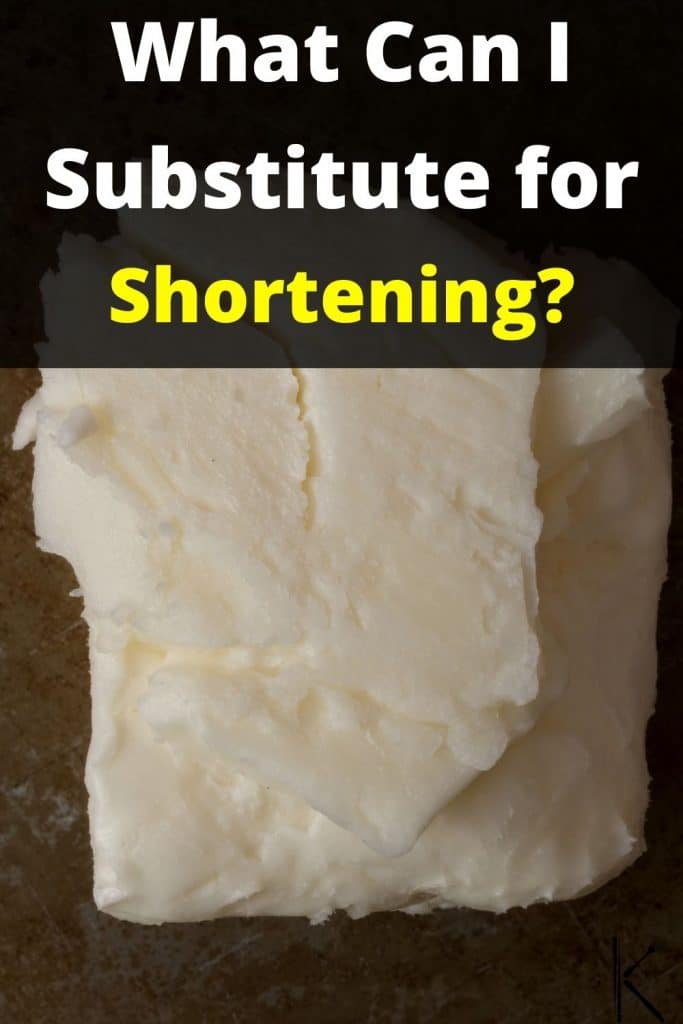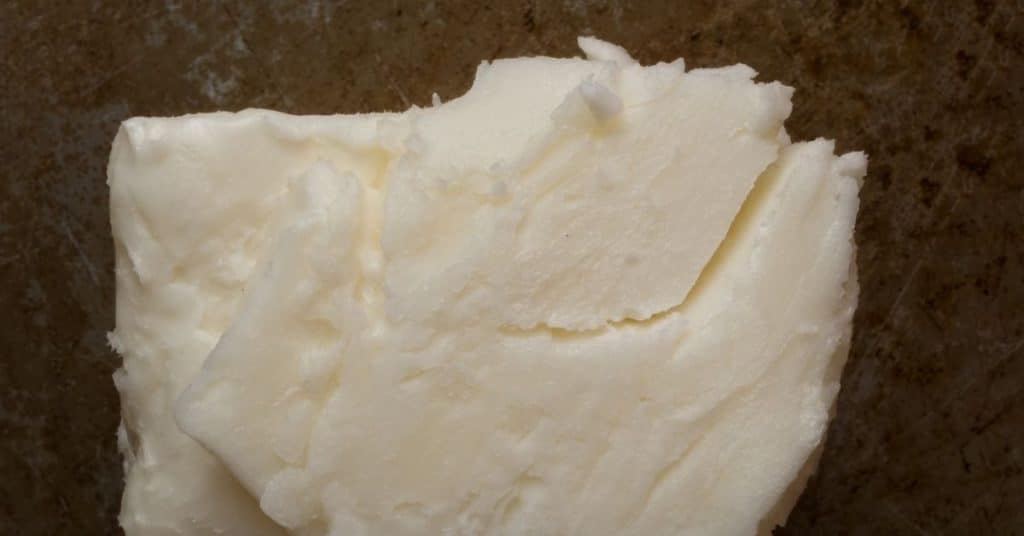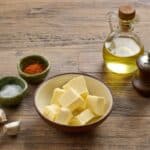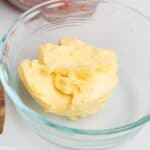In short, there are 6 alternatives to shortening for baking and cooking: butter, coconut oil, lard, margarine, vegetable oil, and cooking spray. Each option has its own unique properties and can be used in various recipes based on preferences and dietary needs.
If you are halfway through measuring out your baking ingredients and realize you’re out of shortening, there’s no need to worry. Chances are, you have a perfectly suitable alternative within easy reach.
Whether you need a quick-fix or are looking for a healthier alternative, this guide will help you pick the best substitutes for shortening.
What is Shortening?
Shortening refers to hydrogenated oils which are solid at room temperature. Shortening is 100% fat. It is designed without any flavor or odor, making it ideal to use in any dish without compromising the flavor profile.
Shortening has a high smoke point, low water content, and does not require refrigeration. Most shortening is made with hydrogenated palm, soybean, and vegetable oils.
Shortening Uses
Shortening is called for in a variety of sweet and savory recipes, both cooked and uncooked. Shortening can be used for:
Baking Pie Crusts and Pastry
Shortening is used in flaky pie crusts where you do not want large air pockets due to gluten. The fat in shortening coats the flour mixture keeping water from activating the components that promote gluten formation. This results in flaky, crumbly golden pie crusts, cookies, or pastries.
Being a solid fat, shortening does not mix fully with dry ingredients in the way oils do. This leaves pockets of solid fat in the dough. As the fat melts during baking, it produces a light and flaky result.
Baking Cakes
Vegetable shortening also contributes to keeping baked goods soft after baking. On cooling, the shortening reverts to its soft, semisolid state allowing cakes and other baked items to remain soft rather than crisp.
Frying
Vegetable shortening is used for frying because there is less chance of splattering under high temperatures. It has a high smoke point and no water content which allows food to cook quickly at high temperatures without the taste of burnt oil.
Frosting
Using shortening instead of butter when making frosting creates a white color, fluffy texture, and results in a topping that handles warm temperatures well.
Butter can separate and melt quickly at warmer temperatures. This can easily result in gloopy or squishy cake frosting especially on warm days.
Greasing
With its high smoke point, shortening is ideal for greasing cooking pans or baking tins.
Best Shortening Replacement for Baking and Cooking
1. Butter
Due to its lower melting point, using butter as a replacement for shortening can make a slight difference in the texture of baked goods. Changes won’t be detrimental, and it generally is a great alternative option for home baking.
Using butter may result in a more (or less) crispy pastry and affect the density of baked goods. Since butter contains water, steam is created during baking which can activate the gluten. This produces a denser dough, crispier cookie, and flaky pie crust.
We always recommend you substitute unsalted butter for shortening. Butter provides a much richer flavor, especially in frosting and cookies. It is not suitable for deep frying.
Substitute quantity: Replace 1 cup shortening in your recipe, with 1 cup butter plus an additional 2 tablespoons of butter.
Best for: Baked items such as cake, pastry, muffins, cookies, pie crusts, and frosting. It can also be used in sauces, for greasing, or sauteing.
See more: Butter alternatives for baking
2. Coconut Oil
Coconut oil is solid at room temperature but softens very quickly when warmed. You can melt it or beat it with sugar as you would shortening. Due to the content of beneficial fats, coconut oil has become popular as a healthier alternative to shortening and butter.
It does, however, have a very high fat content and will not be beneficial in reducing calories.
Unrefined coconut oil has a much more noticeable coconut flavor than refined coconut oil. We therefore recommend using the latter as a substitute.
Cold coconut oil can be used in its solid form for vegan baking, making raw health bars, cookies, frosting, cakes, and desserts.
Melted coconut oil is also suitable for frying, deep frying at mid-temperature, sautéing, roasting, making sauces, and grilling.
Substitute quantity: Coconut oil can substitute shortening in equal measures.
Best for: Baking, greasing, and sauteing.
3. Lard
Lard is an animal fat that has a high smoke point and low water content. This means it won’t splatter when used for frying. It is the best substitute option for obtaining flaky results in pastry cooking and pie crust recipes. Lard should be used in slightly lesser amounts than shortening. Keep in mind that it won’t be suitable for vegans.
Substitute quantity: For every 1 cup of shortening, use 2 tablespoons of lard less. So if your recipe calls for 1 cup of shortening, measure one cup of lard instead and remove 2 tablespoons from the measurement to get the right amount.
Best for: Baking, frying, and greasing.
4. Margarine
Due to its high water content, items baked with margarine will often have a softer texture. This may be ideal for cupcakes and cake. It is a closer substitute match to shortening in terms of flavor than butter.
Substitute quantity: If your recipe calls for shortening, replace one cup of shortening with 1 cup and 2 tablespoons of margarine.
Best for: Baking, greasing, frosting.
5. Vegetable Oil
Vegetable oil is best used for frying and greasing. It can be used as a substitute for shortening in cakes but may work better in certain recipes than others.
Cakes that use a creaming method are best made with shortening or butter. This method requires beating fat with sugar to create a light batter where the air is incorporated during the beating and the volume of the batter increases. The solid fats amplify the aeration process.
Cakes or batters that are made by simply mixing all the ingredients together are safer to substitute oil for shortening with little change in the end product.
Cooking oils are a natural shortening substitute for frying.
Substitute quantity: Substitute an equal measure of oil for shortening in both baking and frying recipes.
Best for: Frying, sauteing, baking, batters such as pancakes and crumpets.
6. Cooking Spray
Some recipes use shortening to grease a saute or baking pan. In this case, using cooking spray is a lighter, easier, and lower-calorie alternative.
Substitute quantity: Spray just enough to lightly and evenly coat your pan or baking dish.
Best for: Greasing only.
FAQs
Applesauce can be used as a shortening replacement in some instances. Since there is no fat in the applesauce it is best to replace only half the amount of shortening with applesauce. Your baked goods will have a denser texture, but the calories will be largely reduced.
While ghee is a good substitute for frying it can also be used in pastry cooking. You may find that the baked pastry will be slightly greasier and short-crust pastries may puff a little. These are however minor matters for home baking. If ghee is all you have on hand go ahead and use it for your pie crust.
Olive oil has a much more distinct flavor than other neutral vegetable oils. While you can use olive oil for light frying and some baked goods, keep in mind that it will slightly change the flavor of your recipe. We don’t recommend using olive oil in lightly flavored items such as vanilla cupcakes or desserts.
Yes, you can use bacon grease, rendered bacon fat, and even chicken fat in savory baked goods. It will impart a different flavor, so make sure that the other flavors in your recipe pair well together.
A substitute for shortening in pie crust can be unsalted butter or lard. Both options will provide a similar flaky texture and contribute to the pie crust’s flavor, though the taste and texture may vary slightly depending on the choice of substitute.
Conclusion
Shortening was designed specifically for the way it yields beautifully flaky pastry. It is, however, easy to substitute with other fats that can work just as well, especially in home cooking.
You may want to be careful with shortening substitutes in frying and in frosting recipes. Choose your substitute carefully according to the flavor, consistency, and melting point. Whether it is lard, coconut oil, butter, or margarine, there is an easy alternative nearby.
Check my other guide on shortening shelf life to learn more.

*image by zkruger/depositphotos









